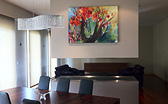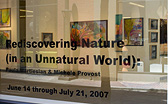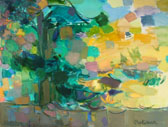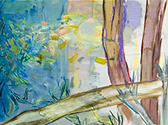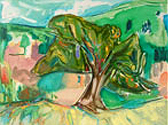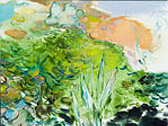Oil
Paintings by Paula Martiesian |
|
| A CURATOR'S PERSPECTIVE by Nancy Whipple Grinnell, Newport Art Museum |
|
|
Paula Martiesian’s paintings are visually stunning; they are full of vibrant color and spiraling shapes; unmannered landscape and riotous flowers. They hark back to the paintings that first awakened my passions as a curator, the beauteous yet startling works by the fauvists and symbolists, the de Kooning like gestures and swirls of the abstract expressionists. It was at the Happy White Gallery in Barrington, Rhode Island where I was first introduced to the work of Martiesian, an artist with longtime roots in the Providence art world. In paintings that depicted trees in bold designs and lush browns, greens, golds and magentas, the artist passionately evoked her relationship with nature and color. “It’s a Jungle Out There” is a series of paintings in which Martiesian continues to mingle the passion she has for paint with the intensity of her feeling for wild, untrammeled gardens. Whether it is her own garden or others, Martiesian prefers the unkempt. No manicured English borders for her; no ornaments, no pristine paths. Martiesian likes her gardens on the wild side—weeds that do well are plants in her world. Is her view of the garden a metaphor for her life? Certainly, in that Martiesian’s garden is allowed to be itself, to grow with abandon, to express its creativity. It is rigidity that Martiesian strives to avoid in both her garden and her art; she ministers to both with fluidity and spontaneity, striving for a balance between chaos and order. Martiesian is a painter’s painter. She says, “I am a person seduced by color and addicted to tubes of paint…Color, in all its infinite variations, is the air I breathe.” On canvas she saturates her space with color; the landscape and floral forms are subordinate. This application of color is an arduous process, Martiesian has to reconcile what she envisions in her head with what she daubs on the canvas. She is seeking to communicate the joy that she finds in her own personal vision of nature. There is no formula; each painting emerges only after a long, solitary process in which the artist often paints and scrapes away, paints and scrapes away again. Martiesian says, “On any given day, you will find me deep in negotiations with cobalt blue and permanent rose.” Martiesian is unapologetic about her embrace of painting as well as the respect she has for its adherents, past and present. She had vital introductions to the medium, both as a painting major at the Rhode Island School of Design, and in her relationship with the artist |
Gordon Peers, her mentor. Peers, who had been chief critic for RISD’s European Honors Program, was a painter of landscapes, portraits and still lifes, as was his late wife, Florence Leif. Both of them were exemplary colorists who drew on the bold hues and angular forms of the post-impressionists, and Martiesian’s debt to them is readily apparent. Martiesian says that Peers’s work was very controlled, and she thinks some of his best paintings were ones that were more spontaneous, painted at the end of his life when he knew time was running out. After graduating from RISD, Martiesian studied privately with Peers until his death in 1988. Her first paintings were still lifes and figure studies. Over time figures and manmade objects lost their interest for Martiesian; she seemed to need a one on one relation with the medium of painting. She concedes to one figurative work in this exhibition; a statue of an angel hovers over gravestones of pastel shades in 'North Burial Ground.' Martiesian’s technique of daubing paint in jewel-like patches enhances the formal qualities of the picture. Imparting a similarly singular view to another Providence location, 'Prospect Street' is a painting ablaze with staccato oranges, pinks, turquoises and yellows. Here an undulating tree trunk in blue seems to do battle with its surrounding speared foliage: this is not the Barbizon forest of Fontainebleau—nor a tranquil, harmonious view of the natural world. In fact, there is not much that is restful in Martiesian’s depictions of nature; the artist’s vision seems to imply that it is, indeed, a jungle out there. In 'Summer Pine,' a brown tree trunk stands stalwart, while around it swirls a a circus of somersaulting branches and tumbling florals, all in dazzling blues, greens and golds. 'Halsey Street Maple' is a veritable raging inferno of colors in flaming appendages. The rollercoaster hill and trees in 'Garrison' do not impart a soothing landscape. Instead, the dark green, jaggedly imposing line of shrubbery cuts an imposing swath into the hillside of irreverent markings. While Martiesian’s 'jungle' is characteristically unruly and at times chaotic, it certainly is not gloomy. The painting 'It’s a Jungle Out There', from whence came the show’s title, is a celebration of color and brushstroke. It is emblematic of all Martiesian’s work, in that it uplifts us with its radiant energy and personal vision. |
